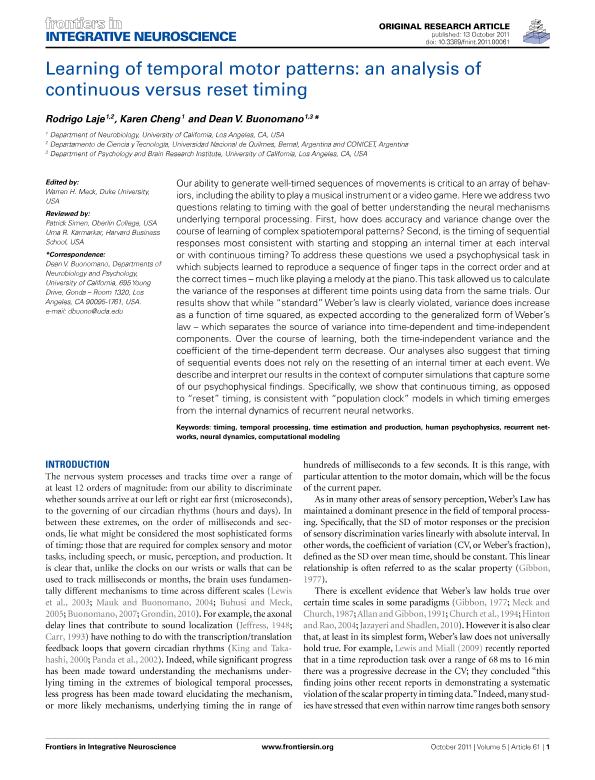Mostrar el registro sencillo del ítem
dc.contributor.author
Laje, Rodrigo

dc.contributor.author
Cheng, Karen
dc.contributor.author
Buonomano, Dean V.
dc.date.available
2023-04-13T15:22:20Z
dc.date.issued
2011-10
dc.identifier.citation
Laje, Rodrigo; Cheng, Karen; Buonomano, Dean V.; Learning of temporal motor patterns: An analysis of continuous versus reset timing; Frontiers Media; Frontiers in Integrative Neuroscience; 5; 10-2011; 1-11
dc.identifier.issn
1662-5145
dc.identifier.uri
http://hdl.handle.net/11336/193739
dc.description.abstract
Our ability to generate well-timed sequences of movements is critical to an array of behav- iors, including the ability to play a musical instrument or a video game. Here we address two questions relating to timing with the goal of better understanding the neural mechanisms underlying temporal processing. First, how does accuracy and variance change over the course of learning of complex spatiotemporal patterns? Second, is the timing of sequential responses most consistent with starting and stopping an internal timer at each interval or with continuous timing? To address these questions we used a psychophysical task in which subjects learned to reproduce a sequence of finger taps in the correct order and at the correct times – much like playing a melody at the piano.This task allowed us to calculate the variance of the responses at different time points using data from the same trials. Our results show that while “standard” Weber’s law is clearly violated, variance does increase as a function of time squared, as expected according to the generalized form of Weber’s law – which separates the source of variance into time-dependent and time-independent components. Over the course of learning, both the time-independent variance and the coefficient of the time-dependent term decrease. Our analyses also suggest that timing of sequential events does not rely on the resetting of an internal timer at each event. We describe and interpret our results in the context of computer simulations that capture some of our psychophysical findings. Specifically, we show that continuous timing, as opposed to “reset” timing, is consistent with “population clock” models in which timing emerges from the internal dynamics of recurrent neural networks.
dc.format
application/pdf
dc.language.iso
eng
dc.publisher
Frontiers Media

dc.rights
info:eu-repo/semantics/openAccess
dc.rights.uri
https://creativecommons.org/licenses/by-nc-sa/2.5/ar/
dc.subject
COMPUTATIONAL MODELING
dc.subject
HUMAN PSYCHOPHYSICS
dc.subject
NEURAL DYNAMICS
dc.subject
RECURRENT NETWORKS
dc.subject
TEMPORAL PROCESSING
dc.subject
TIME ESTIMATION AND PRODUCTION
dc.subject
TIMING
dc.subject.classification
Otras Ciencias Biológicas

dc.subject.classification
Ciencias Biológicas

dc.subject.classification
CIENCIAS NATURALES Y EXACTAS

dc.title
Learning of temporal motor patterns: An analysis of continuous versus reset timing
dc.type
info:eu-repo/semantics/article
dc.type
info:ar-repo/semantics/artículo
dc.type
info:eu-repo/semantics/publishedVersion
dc.date.updated
2023-04-13T14:14:15Z
dc.journal.volume
5
dc.journal.pagination
1-11
dc.journal.pais
Suiza

dc.journal.ciudad
Lausanne
dc.description.fil
Fil: Laje, Rodrigo. Universidad Nacional de Quilmes. Departamento de Ciencia y Tecnología; Argentina. Consejo Nacional de Investigaciones Científicas y Técnicas; Argentina
dc.description.fil
Fil: Cheng, Karen. University Of California At Los Angeles. School Of Medicine. Department Of Neurobiology. Buonomano Lab; Estados Unidos
dc.description.fil
Fil: Buonomano, Dean V.. University Of California At Los Angeles. School Of Medicine. Department Of Neurobiology. Buonomano Lab; Estados Unidos
dc.journal.title
Frontiers in Integrative Neuroscience
dc.relation.alternativeid
info:eu-repo/semantics/altIdentifier/doi/http://dx.doi.org/10.3389/fnint.2011.00061
dc.relation.alternativeid
info:eu-repo/semantics/altIdentifier/url/https://www.frontiersin.org/articles/10.3389/fnint.2011.00061/full
Archivos asociados
